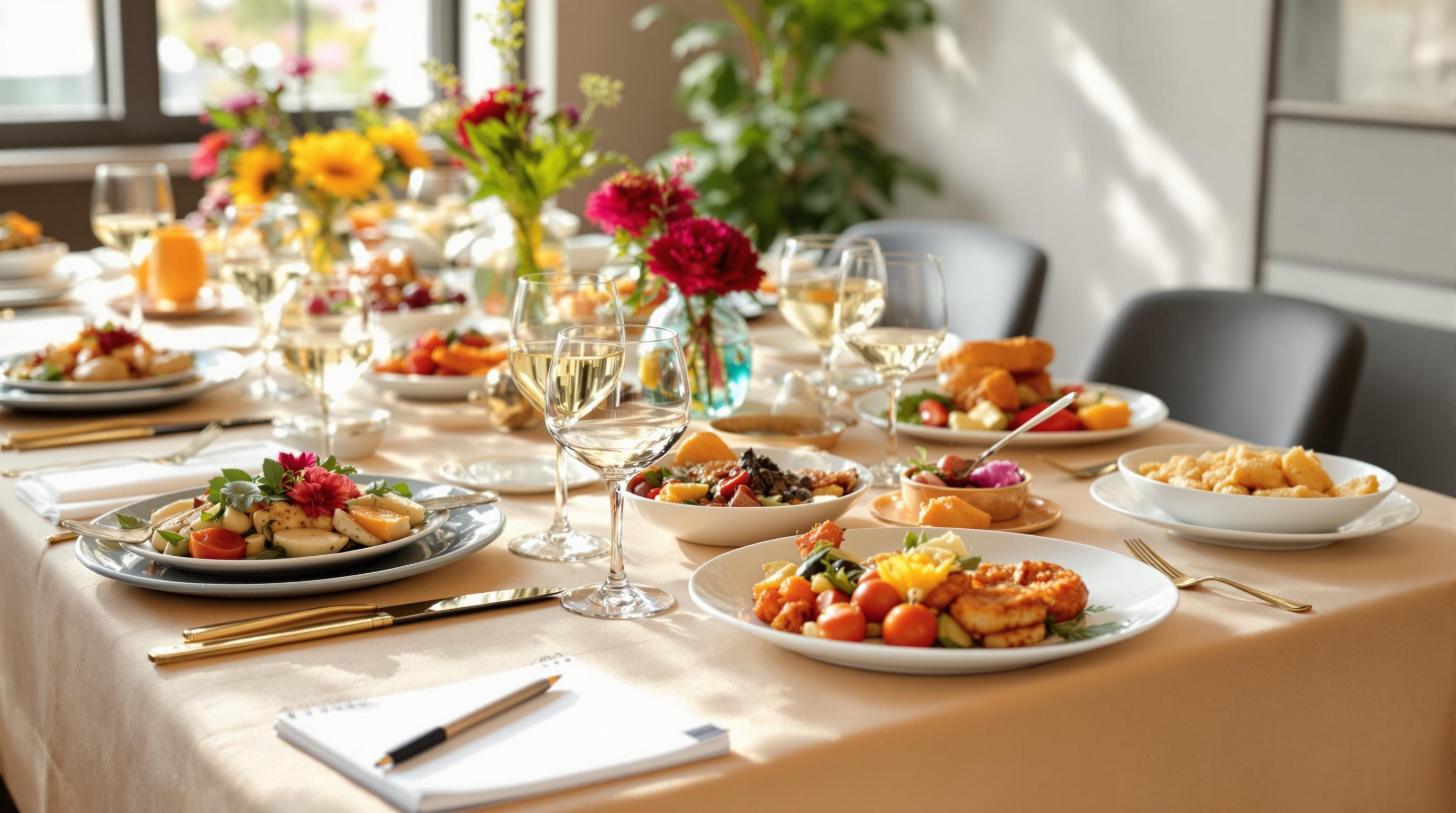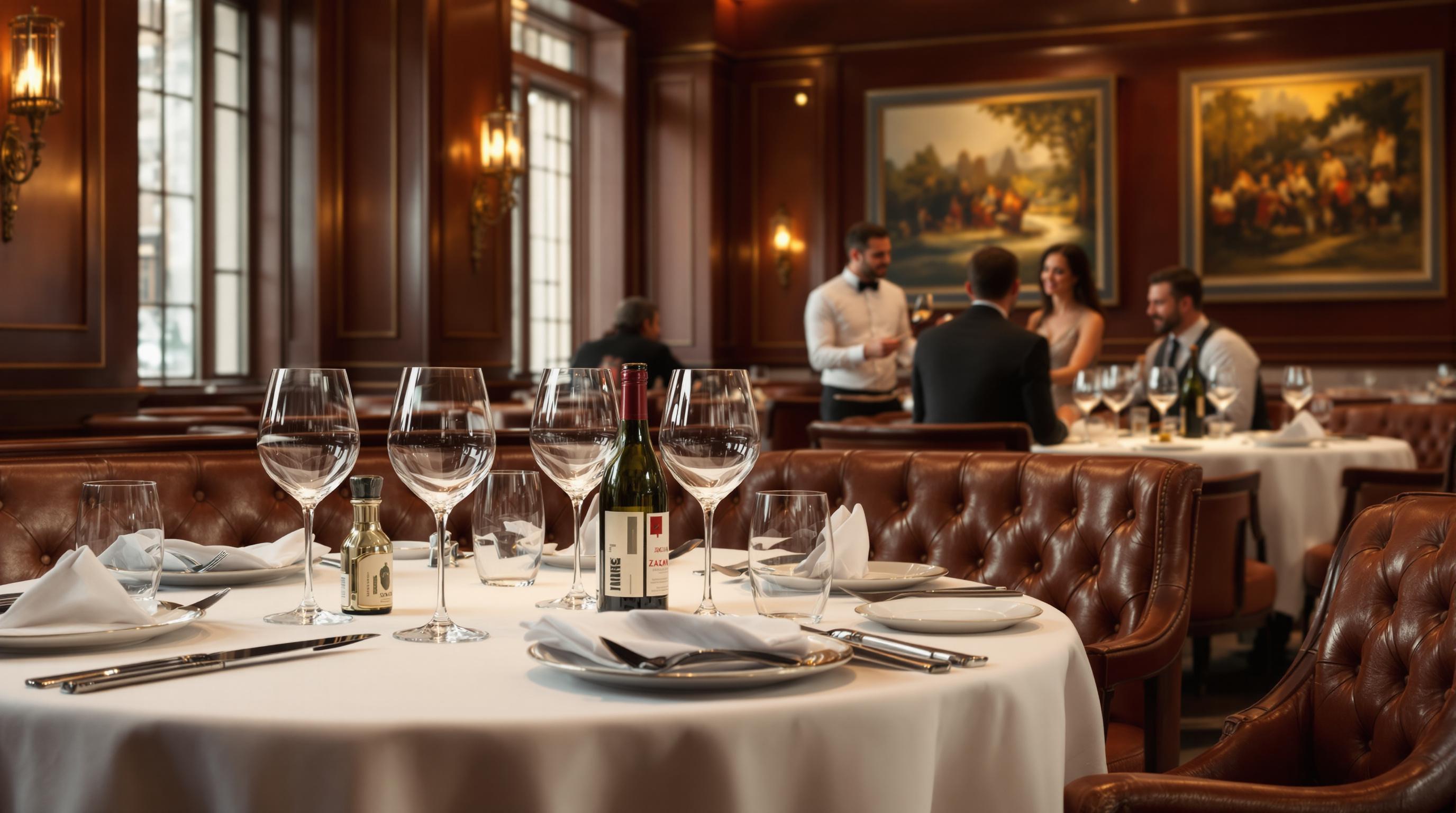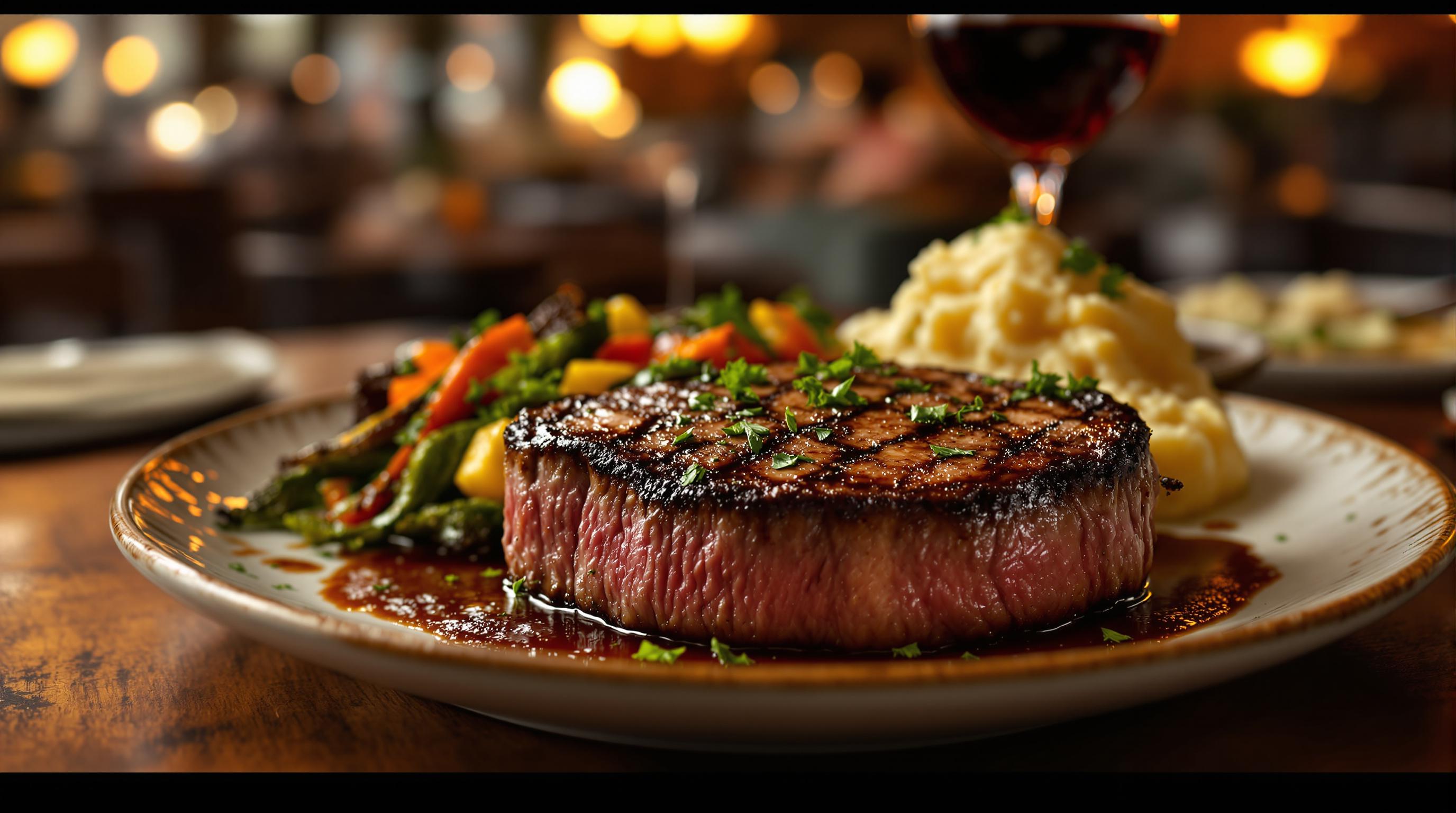Planning a group meal and torn between ribeye and sirloin? Here’s a quick guide to help you decide.
- Ribeye: Rich, tender, and flavorful due to its marbling. Best for bold taste lovers but comes with a higher price tag. Typically served in larger portions (12–16 oz).
- Sirloin: Leaner, firmer, and more affordable. Ideal for budget-conscious groups or those preferring a lighter option. Standard portions are 8–12 oz.
Quick Comparison
| Feature | Ribeye | Sirloin |
|---|---|---|
| Texture | Tender, well-marbled | Lean, firm |
| Flavor | Rich and buttery | Clean, beef-forward |
| Cost | Higher | Lower |
| Serving Size | 12–16 oz | 8–12 oz |
| Best For | Bold flavor seekers | Budget-conscious groups |
For mixed preferences, serving both cuts ensures everyone’s happy. Whether you prioritize taste, cost, or portion size, this guide will help you plan the perfect group dining experience.
Taste and Texture
Ribeye: Juicy and Flavorful
Ribeye is known for its white marbling, which melts during cooking, giving the steak a tender, buttery texture and a bold, rich flavor. Cook it to medium-rare to bring out its juiciness and achieve the perfect balance of taste and tenderness.
Sirloin: Lean and Satisfying
Sirloin delivers a clean, beef-forward flavor with minimal fat. Its firm texture and distinct grain provide a hearty bite, making it a great option for those who prefer a leaner, no-frills steak experience.
Matching Taste Preferences
Choose the right cut based on your group’s preferences:
| Preference Type | Best Cut | Why It Works |
|---|---|---|
| Bold & Indulgent | Ribeye | The marbling adds richness and a melt-in-your-mouth feel |
| Lean & Healthy | Sirloin | Lower fat content makes it a lighter, calorie-conscious choice |
| Mixed Preferences | Both | Offering both ensures everyone gets what they enjoy |
For larger gatherings, serving both cuts is a smart way to cater to a variety of tastes, especially with groups of 8 or more. Everyone gets a steak they’ll love.
Price and Portion Guide
Cost Comparison
When dining with a group, it's important to weigh the costs of different cuts. Ribeye, known for its rich marbling and tenderness, usually comes with a higher price tag. On the other hand, sirloin is a more budget-friendly option. For a high-end dining experience, check out places listed in the NY Steakhouse Guide, where you’ll find premium options like dry-aged cuts - though these come with a steeper price. Beyond the price, planning portions carefully ensures everyone leaves satisfied.
Group Serving Sizes
Portion planning should match the cut's features with your guests' appetites. Ribeye is typically served in portions of 12–16 ounces per person, while sirloin portions are usually 8–12 ounces. To avoid running out, consider adding an extra 15% to your total. Combining different cuts can also help balance costs while offering a variety of flavors for your gathering.
Ribeye or Sirloin Steak: What You Really Need to Know
sbb-itb-e6be165
Group Cooking Methods
When you've sorted out costs and portion planning, the next step is nailing the right cooking techniques to make your group dining experience smooth and enjoyable.
Ribeye Cooking Tips for Groups
Reverse searing is a great way to cook ribeyes for a crowd. Here’s how:
- Preheat your oven to 250°F.
- Arrange up to 10 ribeyes on wire racks placed over baking sheets.
- Cook them until they hit an internal temperature of 115°F, which takes around 45 minutes.
- Sear the steaks in a cast-iron skillet at 500°F for 1-2 minutes per side. Work in batches for the best results.
If you have access to a commercial griddle, you can cook 6-8 ribeyes at once at 400-450°F. Just make sure the steaks are at room temperature before cooking, and season with salt and pepper beforehand.
Sirloin Cooking Tips for Groups
For sirloin steaks, high-heat grilling is your best bet to prevent overcooking:
- Preheat your grill to 450-500°F.
- Use a mix of direct and indirect heat to cook 10-12 steaks at the same time.
If you’re cooking indoors, use several heavy skillets on different burners. Cook each sirloin for 4-5 minutes per side to achieve medium-rare, working in batches of 3-4 steaks at a time. Keep finished steaks warm in an oven set to 170°F until serving.
Kitchen Setup and Timing
Having the right tools and timing is key to serving steaks to a group. Here's a quick guide to your kitchen setup:
| Equipment Needed | Quantity | Purpose |
|---|---|---|
| Meat thermometers | 2-3 | To monitor temperatures |
| Cast-iron skillets | 3-4 | For cooking |
| Sheet pans | 4-6 | For resting steaks |
| Wire racks | 4-6 | To elevate steaks |
| Heavy-duty tongs | 2-3 | For handling steaks |
To keep things organized, stagger your cooking times:
- Start cooking ribeyes about 45 minutes before serving.
- Begin sirloins 25-30 minutes before serving.
- Allow all steaks to rest for 10 minutes before slicing.
Set warming drawers or ovens to 170°F to hold cooked steaks. Use aluminum foil tents to keep the heat in while letting moisture escape. This ensures everything stays warm and flavorful until it’s time to eat.
Nutrition Facts
Understanding the nutritional breakdown can help you make informed choices when planning meals for a group.
Calories and Fat
When comparing a 6-ounce serving, ribeye and sirloin differ significantly in their calorie and fat content:
| Nutritional Element | Ribeye | Sirloin |
|---|---|---|
| Calories | 466 | 348 |
| Total Fat | 37.6g | 19.2g |
| Saturated Fat | 15.8g | 7.4g |
| Monounsaturated Fat | 16.2g | 8.1g |
| Cholesterol | 124mg | 116mg |
Ribeye provides a richer flavor due to its higher fat content, but it might not align with all dietary preferences.
Protein Content
Both cuts are excellent sources of protein, but there are slight differences:
| Nutrient | Ribeye (6 oz) | Sirloin (6 oz) |
|---|---|---|
| Protein | 43.2g | 46.8g |
| Iron | 3.8mg | 3.2mg |
| Zinc | 7.4mg | 6.8mg |
| Vitamin B12 | 2.8mcg | 2.4mcg |
Sirloin packs a bit more protein while keeping fat levels lower, making it a solid choice for those focusing on leaner options.
Diet Considerations
Nutritional factors, along with cost and portion sizes, can help guide your group dining decisions:
- Keto/Low-carb diets: Both ribeye and sirloin are carb-free, but ribeye's higher fat content makes it a better fit for keto plans.
- Low-calorie diets: Sirloin contains about 25% fewer calories than ribeye. For a group of 12, this could save around 1,416 calories overall.
- Heart-health focus: Sirloin has less than half the saturated fat of ribeye, making it a better option for heart-conscious diners.
For a group of 12, serving 4 portions of ribeye and 8 portions of sirloin offers a balanced solution that caters to a variety of dietary needs.
Summary and Tips
Key Differences
Ribeye delivers a rich, flavorful experience thanks to its marbling, making it great for smaller, intimate gatherings. On the other hand, sirloin, with its lean and firm texture, is a more budget-conscious option, perfect for feeding larger groups without breaking the bank.
Choosing for Your Group
- Small groups: Treat them to ribeye for a premium dining experience.
- Medium groups: Serve a mix of ribeye and sirloin to balance flavor and cost.
- Large gatherings: Stick with sirloin to keep expenses in check while still offering a satisfying meal.
NYC Steakhouse Options
Once you've picked your ideal cut, use the NY Steakhouse Guide to find the perfect spot in NYC for your group dinner. The guide makes it easy to match venues with your group size and preferences.


